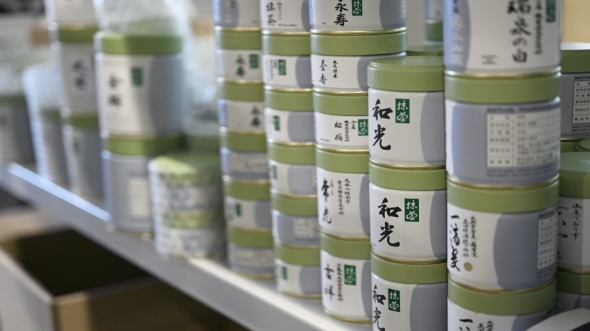
Just like coffee and wine, there can be a dramatic difference between drinking high-quality green tea and mediocre-quality green tea. Even if you have learned the art of pouring a perfect cup or acquired tea ware specifically designed to enhance your favorite green tea variety, the quality of the tea leaf ultimately decides whether you will be experiencing the tea or simply drinking the tea.
But how can you tell if you’re buying tea that is superior or everyday in color, flavor and aroma?
Ways to Measure Tea Quality
Measuring High-Quality Green Tea by Reputation
The first way to measure the quality of Japanese green tea is by looking at:
- Where the tea leaves are grown
- Who is processing the tea
- Who is selling the tea
For experienced green tea drinkers, brand or producer name and region alone can be enough to decide on purchasing one tea over another. However, for newcomers to high-quality tea choosing by brand can be next to impossible without detailed research.
Due to the knowledge necessary to understand the subtle differences between regional locations, Japanese brands and the trustworthiness of tea sellers, this quality of measurement is not recommended for green tea novices.
Measuring High-Quality Green Tea by Flavor
Measuring the quality of green tea by flavor can be a somewhat subjective method, yet since a large part of experiencing green tea is through flavor, it’s nonetheless an important one. This is why a good option when choosing high-quality green tea is to taste it—if you can.
The problem with tasting high-quality green tea before buying is that it’s almost impossible for most people to do. Unless you live in Japan, finding a place that serves and sells high-quality Japanese green tea can be extremely difficult to locate in your local area.
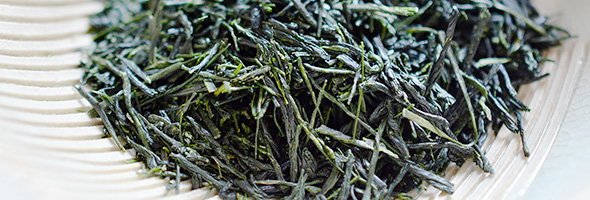
Measuring High-Quality Green Tea by Appearance
The third way to measure quality is by appearance of the tea leaves. If you are given the opportunity to closely examine the leaves, there are three main visual indicators you can look for.
SHAPE OF THE LEAVES
The shape of tea leaves can be a reliable indicator because it directly reflects the selection and production process the tea went through. Looking for this indicator requires experience in understanding the differences between green tea varieties, which is explained below for each variety.
COLOR OF THE LEAVES
Knowing the appropriate shade of green for each green tea variety (with the understanding that some teas like hojicha are brown) can indicate the quality of the tea.
BRIGHTNESS OF THE LEAVES
Bright leaves often indicate good quality, though due to the production process of some teas, like fukamushicha, a greater amount of powder may be found within, resulting in less brightness. Therefore, this indicator shouldn’t be applied to all green tea varieties.
Visual Quality Cues for 9 Japanese Green Tea Varieties
Based on the three visual indicators provided above, you can use the following descriptions and images when shopping for high-quality Japanese green tea. For a closer look at each of the images shown, we invite you to click on the links below.
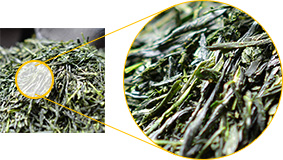
HIGH-QUALITY GYOKURO
High-quality gyokuro has a deep, dark green color with a glossy, damp appearance. Look for gyokuro that has equally sized leaves with a needle-like shape.
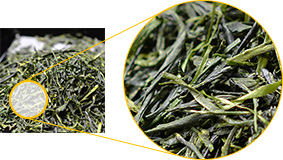
HIGH-QUALITY KABUSECHA
High-quality kabusecha should have a dark green color similar to gyokuro and needle-like leaves similar to sencha.
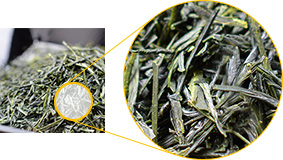
HIGH-QUALITY SENCHA
High-quality sencha is thin and needle-like. It only contains leaves that are in good shape. Glossy, deep dark green.

HIGH-QUALITY FUKAMUSHICHA
High-quality fukamushicha has a deep green color with a hint of light green. Avoid fukamushicha that has too much powder.

HIGH-QUALITY KUKICHA (KARIGANE)
High-quality kukicha should contain mostly equally sized stems with a few tea leaves and be sourced from gyokuro or kabusecha tea fields. You may also find some kukicha blended with matcha, which usually indicates good quality.
As for whether or not there is any difference in quality between kukicha and karigane, don’t worry, they are just different names for the same variety of tea. Some sources may try to tell you otherwise, but that is false information.

HIGH-QUALITY KONACHA
High-quality konacha should have a grassy green color and contain small particles that look like tea powder. When buying konacha, it’s very important to know whether it’s identified as sencha konacha or gyokuro konacha. Premium konacha will always come from gyokuro or kabusecha tea fields and have a very fresh aroma and a vivid grassy green color.

HIGH-QUALITY KAMAIRICHA
High-quality kamairicha should have a matted, deep green color and tea leaves that show a nice curl (similar to a hook).
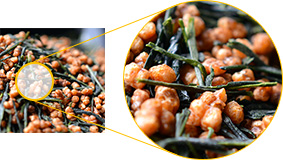
HIGH-QUALITY GENMAICHA
High-quality genmaicha should only contain leaves that are in good shape. The roasted rice should be plump and oval; not small and round. The popcorn-like rice is a result of the roasting process and does not affect the quality of the genmaicha, rather they are left in to add decoration.

HIGH-QUALITY HOJICHA
High-quality hojicha should be brown, not black, which indicates burning during the roasting process. It is better to have less powder.
4 Ways to Buy High-quality Green Tea
Once you have chosen a tea variety and understand its unique visual indicators, you can begin shopping. The four main options for buying green tea are:
Japanese Tea Shops
The ability to customize tea weight as well as taste the tea you’ll be buying is why some choose to purchase their tea from a physical location. If the tea store specializes in a specific type of tea, it’s possible to also find a staff member who is knowledgeable in answering your questions.
Be wary though of stores that simply repeat to you what’s on the back of the label, can’t answer questions, or store their tea in direct sunlight. For high-quality Japanese tea, it’s rare to find a tea store outside of Japan that can provide a large assortment of premium tea varieties due to low turnover as well.
Japanese Tearooms
A Japanese tearoom is similar to a café where the tea varieties being served are carefully selected by the tearoom owner. Often, the tea leaves are also available for purchase. What makes this option appealing is that because they regularly prepare the tea for customers, you can ask firsthand how to prepare the tea you’re interested in.
Again, like tea stores, Japanese tearooms are quite common throughout Japan; however, it can be difficult to find similar high-quality tea being sold and served internationally. Fortunately, there are other options available.
Supermarkets
If you can find a Japanese supermarket in your area, you can potentially find a limited selection of medium-quality Japanese tea on the shelves. It’s extremely important that you check the package’s food label, as the tea may very well be expired or close to expiring.
This option can work in a pinch, but if you have questions it is unlikely that the supermarket staff will be able to assist you.
Online Tea Shops
If you cannot find a Japanese tea store or café near your home, you can still easily find high-quality Japanese green tea for sale online.
Of the three indicators mentioned above (brand reputation, flavor and appearance) the only one that can be difficult to determine with this purchasing method is the green tea flavor profile. However, if the online tea store provides detailed information about the tea with clear images of what you will be buying, you can likely trust that their tea selection is in fact high-quality and that they are taking the necessary steps in sourcing, storing, packing and shipping the tea before it’s delivered to your doorstep.
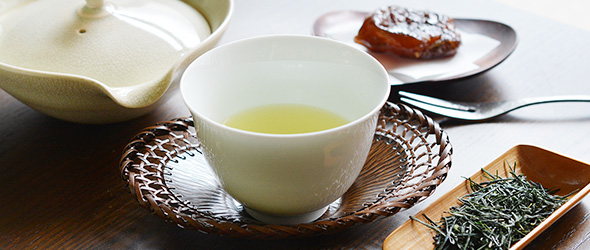
Finding High-Quality Japanese Green Tea with Sazen Tea
By choosing high-quality green tea, you are giving yourself the chance to once again discover the pure joy of that first sip. Sazen Tea helps to make this experience with their assorted varieties of premium Japanese green tea produced by some of Japan’s most respected brands. We invite you to peruse through our selection of green tea and see firsthand with our high-resolution images exactly what you will be purchasing. If you need further guidance on choosing a variety that fits your flavor and aroma preferences, then we suggest reading through our beginner’s guide to selecting the perfect green tea.


